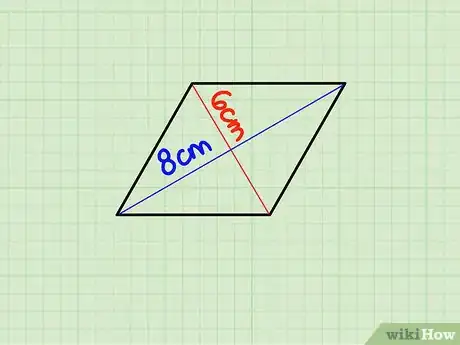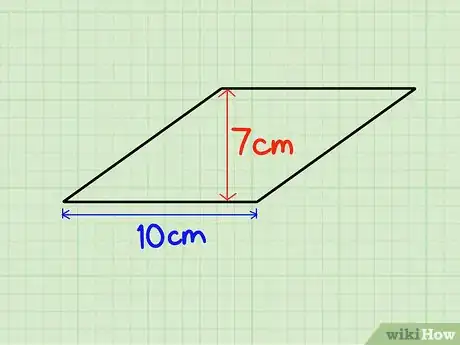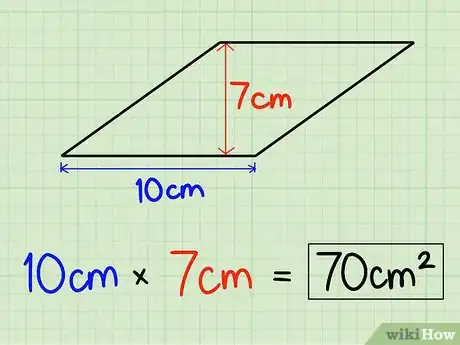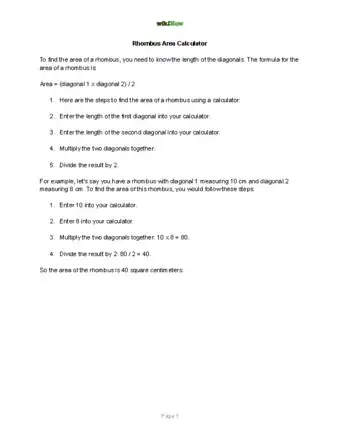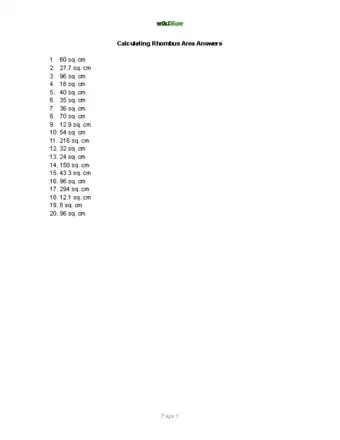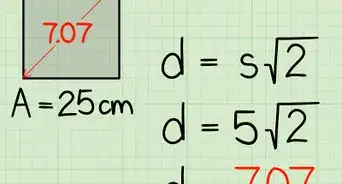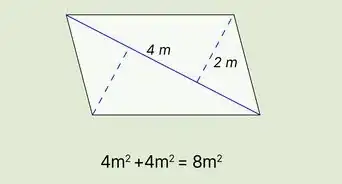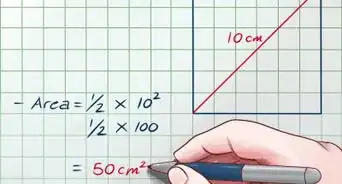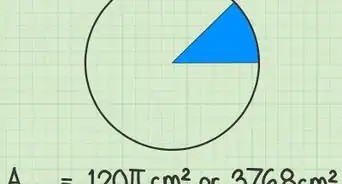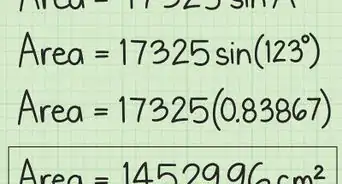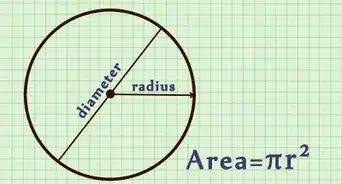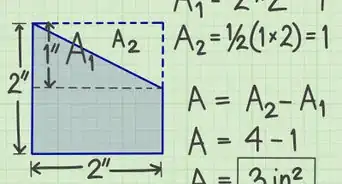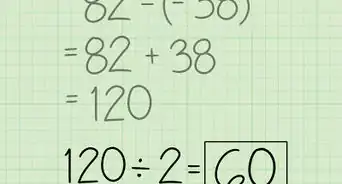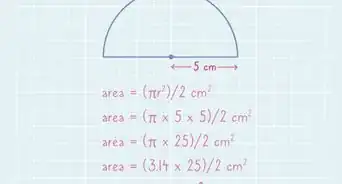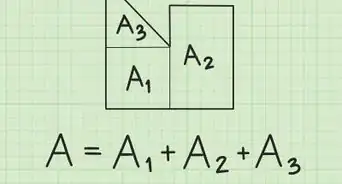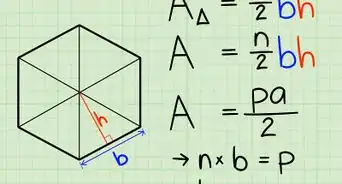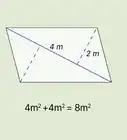wikiHow is a “wiki,” similar to Wikipedia, which means that many of our articles are co-written by multiple authors. To create this article, 32 people, some anonymous, worked to edit and improve it over time.
This article has been viewed 869,529 times.
Learn more...
A rhombus is a parallelogram with four congruent sides. It does not have to have right angles.[1] There are three formulas for finding the area of a rhombus. Just follow these steps if you want to know how to do it.
Steps
Using the Diagonals
-
1Find the length of each diagonal. The diagonals of a rhombus are the lines that connect the opposite vertices (corners) in the center of the shape. The diagonals of a rhombus are perpendicular and form four right triangles through their intersection.[2]
- Let's say the diagonals are 6 cm. and 8 cm. long.
-
2Multiply the length of the diagonals. Just write down the length of the diagonals and multiply them. In this case, 6 cm x 8 cm = 48 cm2. Don't forget to square the units since you're working in square units.[3]Advertisement
-
3Divide the result by 2. Since 6 cm x 8 cm = 48 cm2, just divide the result by 2. 48 cm2/2 = 24 cm2. The area of the rhombus is 24 cm2.[4]
Using the Base and Height
-
1Find the base and the height.[5] You can also think of this as multiplying the altitude of the rhombus with the length of the side of the rhombus. Let's say the height of the rhombus is 7 cm and the base is 10 cm.
-
2Multiply the base and height. Once you know the base and height of the rhombus, all you have to do to find the area of the shape is to multiply them. So, 10 cm x 7 cm = 70 cm2. The area of the rhombus is 70 cm2.[6]
Using Trigonometry
-
1Square the length of any side. A rhombus has four equal sides, so it doesn't matter which side you choose. Let's say the side is 2 cm long. 2 cm x 2 cm = 4 cm2.[7]
-
2Multiply it by the sine of one of the angles. It doesn't matter which angle you choose. Let's say one of the angles is 33 degrees. Just multiply sine (33) by 4 cm2 to get the area of the rhombus. (2 cm)2 x sine (33) = 4 cm2 x 0.55 = 2.2 cm2. The area of the rhombus is 2.2 cm2.[8]
Rhombus Area Calculator, Practice Problems, and Answers
Community Q&A
-
QuestionHow do I find the perimeter of a rhombus?
 Community AnswerPerimeter = sum of all sides. The rhombus has equal sides, so its perimeter = side x 4.
Community AnswerPerimeter = sum of all sides. The rhombus has equal sides, so its perimeter = side x 4. -
QuestionHow can I find the height of a rhombus?
 Community AnswerIn a rhombus, the diagonals bisect and are perpendicular, meaning that inside the rhombus there are four right-angle triangles, with side lengths half that of the diagonals, use the pythagoran theorem to find the hypotenuses a² + b² = c² Now we have the base, given any of the angles inside the rhombus, we can find all of them because they are corresponding and all add up to 360 degrees, once we have all of the angles, another two identical triangles appear. we only have to use one of these as they are identical. Now we have the hypotenuse and an angle of this triangle so using trigonometry we can find the adjacent side which is the height of the rhombus.
Community AnswerIn a rhombus, the diagonals bisect and are perpendicular, meaning that inside the rhombus there are four right-angle triangles, with side lengths half that of the diagonals, use the pythagoran theorem to find the hypotenuses a² + b² = c² Now we have the base, given any of the angles inside the rhombus, we can find all of them because they are corresponding and all add up to 360 degrees, once we have all of the angles, another two identical triangles appear. we only have to use one of these as they are identical. Now we have the hypotenuse and an angle of this triangle so using trigonometry we can find the adjacent side which is the height of the rhombus. -
QuestionHow do I determine the perimeter given one diagonal and the area?
 Community AnswerUse the Pythagorean theorem to find the sides and then find the perimeter.
Community AnswerUse the Pythagorean theorem to find the sides and then find the perimeter.
References
- ↑ https://www.mathsisfun.com/geometry/rhombus.html
- ↑ https://www.mathopenref.com/rhombusarea.html
- ↑ https://www.omnicalculator.com/math/rhombus-area
- ↑ https://www.omnicalculator.com/math/rhombus-area
- ↑ https://www.omnicalculator.com/math/rhombus-area
- ↑ https://www.omnicalculator.com/math/rhombus-area
- ↑ https://byjus.com/maths/area-of-rhombus/
- ↑ https://byjus.com/maths/area-of-rhombus/
About This Article
A rhombus is a shape with four equal sides, each of which is parallel to the opposite side. While a square is a type of rhombus, they can also be diamond-shaped, with angles of greater or less than 90° at each corner. There are several easy ways to find the area of a diamond-shaped rhombus. One is to measure the rhombus diagonally from corner to corner, each way. For instance, let’s say your rhombus measures 10 cm across lengthwise and 6 cm across widthwise. Once you find the length of each diagonal, multiply the lengths together. In this case, 10 cm x 6 cm = 60 cm. Finally, divide the result by 2. Don’t forget to square your units when you write the result, since you’re measuring the area. 60/2 = 30, so our rhombus has an area of 30 cm squared. Another simple method is to multiply the base length of the rhombus by its height. Measure the width of the bottom line of the rhombus, then take a perpendicular measurement from the base to the opposite line at the top. Multiply the measurements together to find the area. For instance, if a rhombus is 12 cm long at the base and has a height of 8 cm, the area of the rhombus would be 96 cm squared. If you only know the length of one side of the rhombus and one of the angles, you can still figure out the area using trigonometry. To do this, square the length of the known side, then multiply the result by the sine of one of the angles. For instance, if the rhombus has one side with a length of 6 cm, and you know it contains a 45° angle, the area would be 36 cm squared x sin(45°), or approximately 30.63 cm squared. If you want to learn how to use trigonometry to find the area of the rhombus, keep reading the article!
